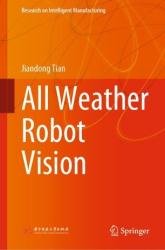 Название: All Weather Robot Vision
Название: All Weather Robot VisionАвтор: Jiandong Tian
Издательство: Huazhong University of Science and Technology Press, Springer
Год: 2022
Страниц: 315
Язык: английский
Формат: pdf (true)
Размер: 14.7 MB
Research has shown that more than 70% of information that humans receive is perceived by vision. Similarly, vision systems are also very important for robots and have basically become the standard configuration of robots. It is fundamental for robots to understand the environment and execute tasks, and it is also an important entrance to realize robot intelligence. With the rapid development of Deep Learning (DL) technology in recent years, task-oriented researches in vision, such as visual servoing, target recognition, tracking, and image understanding, have made remarkable progress. However, it should be noted that these visual algorithms are all developed for images with good quality and stable lighting conditions. In fact, robots often need to work in complex, dynamic, or unstructured environment. At this time, vision algorithms often lack adaptive ability and robustness to the environment. This problem has always been an important research content of robot vision and other related disciplines, but it has not been well solved yet.
This book focuses on image preprocessing for robot vision in outdoor dynamic illumination and weather conditions which are real challenges for field robots, autonomous cars, and surveillance. Different from the previous methods which mainly perform mathematical processing or Machine Learning (ML) on image data, this book will expound the modeling and analysis for illumination and weather phenomena in images from the perspective of studying physical imaging mechanism. This book will systematically discuss the environmental perception, modeling, and image preprocessing technologies of robot vision systems in complex illumination and bad weather conditions, based on the author’ s previous publications. It has some scientific significance to improve a robot’ s environmental perception ability and environmental compatibility. Meanwhile, these contents also have some reference and application value for other outdoor vision systems such as automatic driving, city monitoring, remote sensing, and underwater vision, making them with the ability to work under different illumination and weather conditions. We name it all-weather robot vision.
The content of this book mainly includes methods for outdoor spectral irradiance calculation, camera imaging modeling, reflectance spectrum calculation, relighting, as well as models and removal algorithms for shadow, highlight, rain, snow, fog, and underwater scattering. The structure of this book is as follows: Chap. 1 is an introduction, mainly explaining the basic principles of color matching and scene reproduction, summarizing the key technologies of all-weather robot vision; Chap. 2 mainly elaborates the analysis and calculation for spectral irradiance of outdoor light source and the reconstruction of reflection spectrum based on images; Chap. 3 mainly elaborates the camera imaging modeling and camera response functions estimation; Chap. 4 mainly elaborates shadow modeling, detection, and feature evaluation; Chap. 5 mainly elaborates the intrinsic-image deriving and illumination decomposition; Chap. 6 mainly elaborates the shadow and reflection removal; Chap. 7 mainly elaborates the rain and snow modeling and removal; Chap. 8 mainly elaborates the image defogging; Chap. 9 mainly elaborates the underwater scattering modeling and removal; Chap. 10 shows some application examples of all-weather robot vision and makes a simple research prospect.
The book offers a valuable resource for researchers, graduate students and engineers in the fields of robot engineering and computer science.
Скачать All Weather Robot Vision